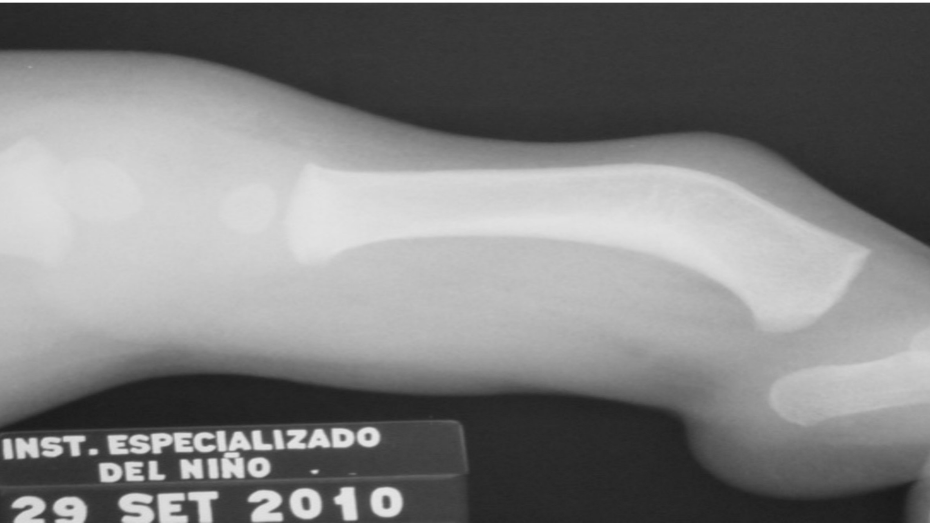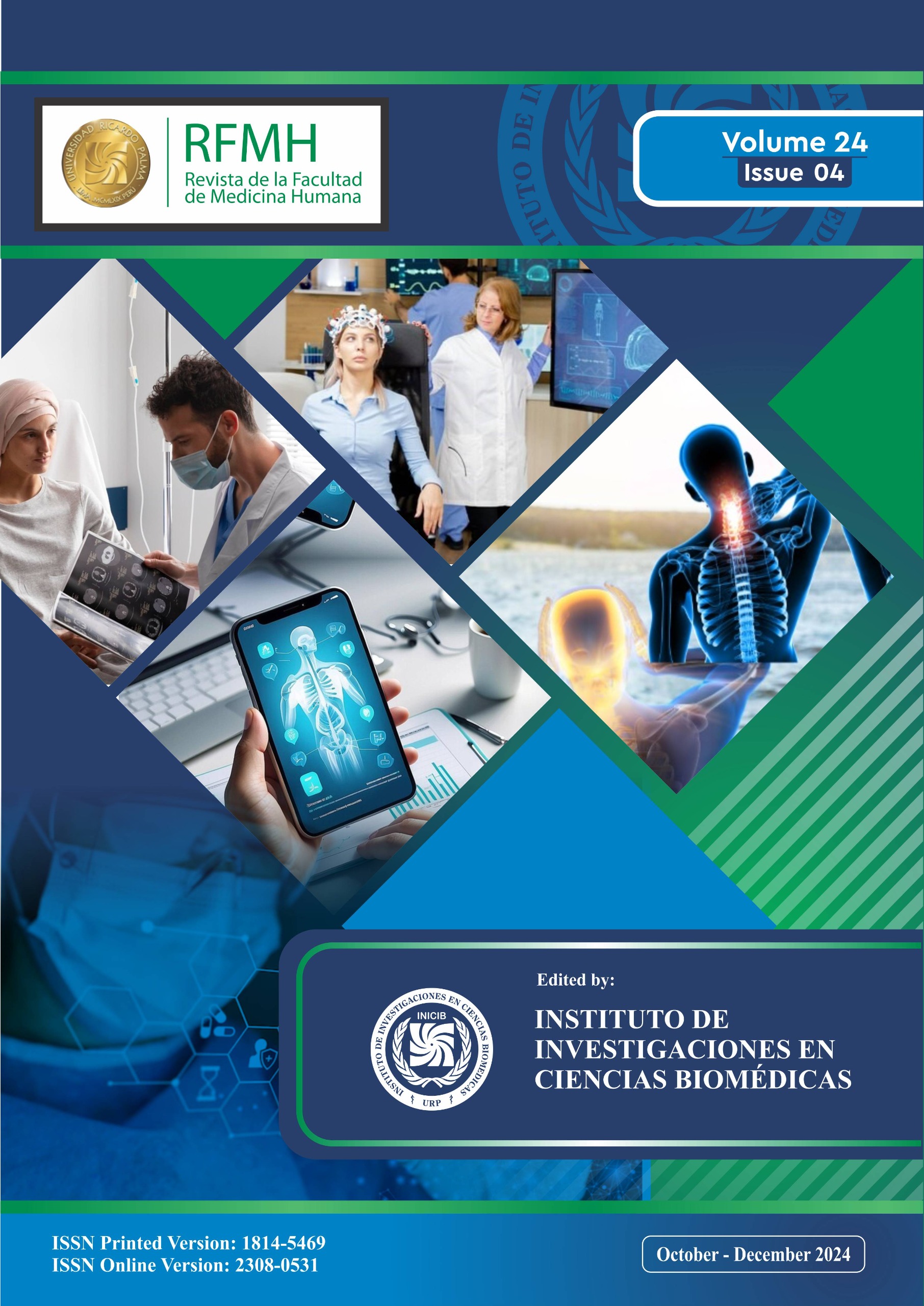Enfermedad ultra rara frecuente en Perú: Reporte de casos del síndrome fatco
Ultra-rare frequent disease in Peru: Fatco syndrome case report
Palabras clave:
Aplasia de fíbula, campomelia de tibia, oligodactilia, síndrome FATCOResumen
El síndrome FATCO (fibular aplasia, tibial camptomelia, oligosyndactyly) está caracterizado por la presencia de anomalías en miembros inferiores. Es una enfermedad, de la cual no se ha precisado la etiología genética hasta la actualidad; sin embargo, se ha planteado que el tipo de herencia es dominante autosómica. La frecuencia de presentación a nivel global es muy rara y esta es la razón principal de los pocos pacientes publicados hasta la fecha.
Existe un reporte de la presentación inusual de catorce pacientes peruanos, diagnosticados en un solo centro, con las características clínicas del síndrome FATCO en un período de 13 años. A la fecha, se han publicado catorce pacientes a nivel mundial, con los cuales se comparó y discutió los datos clínicos y radiológicos. Además, se analizaron las características demográficas, antecedentes familiares, sexo, edad y anomalías concomitantes.
Descargas
Citas
Courtens W, Jespers A, Harrewijn I, Puylaert D, Vanhoenacker F. Fibular aplasia, tibial campomelia, and oligosyndactyly in a male newborn infant: A case report and review of the literature [Internet]. Vol. 134 A, American Journal of Medical Genetics. Am J Med Genet A; 2005 [cited 2020 Oct 9]. p. 321–5. Disponible en: https://pubmed.ncbi.nlm.nih.gov/15754355/
Lewin SO, Opitz JM. Fibular a/hypoplasia: review and documentation of the fibular developmental field. [Internet]. Vol. 2, American journal of medical genetics. Supplement. Am J Med Genet Suppl; 1986 [cited 2020 Oct 9]. p. 215–38. Disponible en: https://pubmed.ncbi.nlm.nih.gov/3146293/
Fibular hemimelia: a new classification system - PubMed [Internet]. [cited 2020 Oct 9]. Disponible en: https://pubmed.ncbi.nlm.nih.gov/12499939/
Holder-Espinasse M, Devisme L, Thomas D, Boute O, Vaast P, Fron D, et al. Pre- and Postnatal Diagnosis of Limb Anomalies: A Series of 107 Cases [Internet]. Vol. 124 A, American Journal of Medical Genetics. Wiley-Liss Inc.; 2004 [cited 2020 Oct 9]. p. 417–22. Disponible en: https://pubmed.ncbi.nlm.nih.gov/14735595/
Lenz W, Zygulska M, Horst J. FFU complex: an analysis of 491 cases. Hum Genet [Internet]. 1993 May [cited 2020 Oct 9];91(4):347–56. Disponible en: https://pubmed.ncbi.nlm.nih.gov/8500790/
Bain AD, Barrett HS. Congenital bowing of the long bones: Report of a case. Arch Dis Child [Internet]. 1959 [cited 2020 Oct 9];34(178):516–24. Disponible en: https://www.ncbi.nlm.nih.gov/pmc/articles/PMC2012421/
Orphanet: Síndrome FATCO [Internet]. [cited 2021 May 26]. Disponible en: https://www.orpha.net/consor/cgi-bin/OC_Exp.php?lng=ES&Expert=2492
Ceausu I, Iliescu D, Poalelungi C, Posea C, Bacalbasa N, Dobritoiu D, et al. The Antenatal Detection of Fetal Limb Anomalies. In: Congenital Anomalies - From the Embryo to the Neonate [Internet]. InTech; 2018 [cited 2020 Oct 9]. doi: https://doi.org/10.5772/intechopen.76108
Hecht JT, Scott CI. Limb deficiency syndrome in half-sibs. Clin Genet [Internet]. 1981 [cited 2021 May 28];20(6):432–7. Disponible en: https://pubmed.ncbi.nlm.nih.gov/7337959/
Guio H, Poterico JA, Levano KS, Cornejo-Olivas M, Mazzetti P, Manassero-Morales G, et al. Genetics and genomics in Peru: Clinical and research perspective. Mol Genet Genomic Med [Internet]. 2018 Nov 1 [cited 2020 Oct 9];6(6):873–86. doi: https://doi.org/10.1002/mgg3.533
D’Amato Gutiérrez M, Palacio Díaz FA. Reporte de caso de síndrome FATCO: aplasia fibular, campomelia de tibia y oligosindactilia. Arch argent pediatr [Internet]. 2016 [cited 2020 Oct 16];e167–70. Disponible en: https://www.sap.org.ar/docs/publicaciones/archivosarg/2016/v114n3a19.pdf
Sezer O, Gebesoglu I, Yuan B, Karaca E, Gokce E, Gunes S. Fibular aplasia, tibial campomelia, and oligosyndactyly: A further patient with a 2-year follow-up. Clin Dysmorphol [Internet]. 2014 [cited 2020 Oct 9];23(4):121–6. Disponible en: https://pubmed.ncbi.nlm.nih.gov/25144151/
Vyskocil V, Dortova E, Dort J, Chudacek Z. FATCO syndrome - fibular aplasia, tibial campomelia and oligosyndactyly [Internet]. Vol. 78, Joint Bone Spine. Joint Bone Spine; 2011 [cited 2020 Oct 9]. p. 217–8. Disponible en: https://pubmed.ncbi.nlm.nih.gov/20947407/
Isik E, Atik T, Ozkinay F. The first report of fibular agenesis, tibial campomelia, and oligosyndactyly syndrome with hydrocephaly. Clin Dysmorphol [Internet]. 2019 [cited 2020 Oct 9];28(1):38–40. Disponible en: https://pubmed.ncbi.nlm.nih.gov/30260844/
Ekbote A V., Danda S. A case report of fibular aplasia, tibial campomelia, and oligosyndactyly (FATCO) syndrome associated with klinefelter syndrome and review of the literature. Foot Ankle Spec [Internet]. 2012 Feb [cited 2020 Oct 9];5(1):37–40. Disponible en: https://pubmed.ncbi.nlm.nih.gov/21965580/
Bieganski T, Jamsheer A, Sowinska A, Baranska D, Niedzielski K, Kozlowski K, et al. Three new patients with FATCO: Fibular agenesis with ectrodactyly. Am J Med Genet Part A [Internet]. 2012 Jul [cited 2021 Feb 17];158 A(7):1542–50. Disponible en: https://pubmed.ncbi.nlm.nih.gov/22628253/
Girisha KM, Vasudevan TG, Saadi AV, Shah H, Gopinath PM, Satyamoorthy K. Hypoplasia/aplasia of pelvis, femora, fibulae, ulna, digits and nails: Fuhrmann syndrome without WNT7A mutations. Clin Dysmorphol [Internet]. 2011 Oct [cited 2020 Dec 11];20(4):205–9. Disponible en: https://pubmed.ncbi.nlm.nih.gov/21716096/
Shah K, Shah H. Tibial hypoplasia with a bifid tibia: an unclassified tibial hemimelia. BMJ Case Rep [Internet]. 2016 Aug 16 [cited 2020 Dec 11];2016. Disponible en: https://pubmed.ncbi.nlm.nih.gov/27530878/
Ahmad M, Abbas H, Wahab A, Haque S. Fibular hypoplasia and complex brachydactyly (Du Pan syndrome) in an inbred Pakistani kindred. Am J Med Genet [Internet]. 1990 [cited 2021 Feb 17];36(3):292–6. Disponible en: https://pubmed.ncbi.nlm.nih.gov/2363425/
Önder Yılmaz H, Topak D, Yılmaz O, Çakmaklı S. A Turkish Female Twin Sister Patient with Fibular Aplasia, Congenital Tibia Pseudoarthrosis, Oligosyndactyly, and Negative WNT7A Gene Mutation. J Pediatr Genet [Internet]. 2019 Jun [cited 2020 Oct 9];08(02):095–9. Disponible en: https://pubmed.ncbi.nlm.nih.gov/31061754/
Kitaoka T, Namba N, Ji YK, Kubota T, Miura K, Miyoshi Y, et al. A Japanese male patient with “fibular aplasia, tibial campomelia and oligodactyly”: An additional case report. Clin Pediatr Endocrinol [Internet]. 2009 Jul [cited 2020 Oct 9];18(3):81–6. Disponible en: https://pubmed.ncbi.nlm.nih.gov/23926365/
Abdalla E, El-Beheiry A. Overlap between Fibular Aplasia, Tibial Campomelia, and Oligosyndactyly and Fuhrmann’s Syndromes in an Egyptian Female Infant. J Pediatr Genet [Internet]. 2017 Jan 2 [cited 2020 Oct 16];06(02):118–21. doi: https://doi.org/10.1055/s-0036-1597931
Izadi M, Salehnia N. Prenatal diagnosis of FATCO syndrome (Fibular aplasia, tibial campomelia, and oligosyndactyly) with 2D/3D ultrasonography. Ultrasound Int Open [Internet]. 2020 Sep 1 [cited 2021 Feb 17];6(2):E44–7. doi: https://doi.org/10.1055/a-1225-4388
FATCO Syndrome Variant - Fibular Hypoplasia, Tibial Campomelia and Oligosyndactyly -- A Case Report - PubMed [Internet]. [cited 2020 Oct 9]. Disponible en: https://pubmed.ncbi.nlm.nih.gov/25386471/
Goyal N, Kaur R, Gupta M, Bhatty S, Paul R. FATCO syndrome variant - Fibular hypoplasia, Tibial campomelia and oligosyndactyly –– A case report. J Clin Diagnostic Res [Internet]. 2014 [cited 2020 Oct 9];8(9):LD01–2. Disponible en: https://pubmed.ncbi.nlm.nih.gov/25386471/
Shah, K., & Shah, H. (2016). Tibial hypoplasia with a bifid tibia: an unclassified tibial hemimelia. BMJ Case Reports, 2016. doi: https://doi.org/10.1136/bcr-2016-216622
Matalon, D. R., Bhoj, E. J., Li, D., McDougall, C., Schindewolf, E., Khalek, N., Wilkens, A., McManus, M., Deardorff, M. A., & Zackai, E. H. (2023). Genomic sequencing in a cohort of individuals with fibular aplasia, tibial campomelia, and oligosyndactyly (FATCO) syndrome. American Journal of Medical Genetics Part A. doi: https://doi.org/10.1002/AJMG.A.63105
A M-M, D C, M B, J M, C A, M B, et al. From gestalt to gene: early predictive dysmorphic features of PMM2-CDG. J Med Genet [Internet]. 2019 Apr 1 [cited 2021 Oct 10];56(4):236–45. Disponible en: https://pubmed.ncbi.nlm.nih.gov/30464053/
S K, NC Ø, OJ B, T G, JOB J, C M, et al. Encoding Clinical Data with the Human Phenotype Ontology for Computational Differential Diagnostics. Curr Protoc Hum Genet [Internet]. 2019 Sep 1 [cited 2021 Oct 10];103(1). Disponible en: https://pubmed.ncbi.nlm.nih.gov/31479590/
Levy SE, Myers RM. Advancements in Next-Generation Sequencing. Annu Rev Genomics Hum Genet. 31 de agosto de 2016;17(1):95-115. doi: https://doi.org/10.1146/annurev-genom-083115-022413
Warr A, Robert C, Hume D, Archibald A, Deeb N, Watson M. Exome Sequencing: Current and Future Perspectives. G3 Genes Genomes Genet. 1 de agosto de 2015;5(8):1543-50. doi: https://doi.org/10.1534/g3.115.018564
Mitos, leyendas y cuentos peruanos - José María Arguedas, Francisco Izquierdo Ríos - Google Libros [Internet]. [cited 2021 Dec 4]. Disponible en: https://books.google.com.pe/books?id=2YEs2nKgLbc

Descargas
Publicado
Cómo citar
Número
Sección
Licencia
Derechos de autor 2023 Revista de la Facultad de Medicina Humana

Esta obra está bajo una licencia internacional Creative Commons Atribución 4.0.





























